An Integrated Intelligent Approach for Monitoring and Management of a Deep Foundation Pit in a Subway Station
Abstract
:1. Introduction
2. Implementation Path of Intelligent Foundation Pit Engineering
3. Project Overview
4. Three-Dimensional Transparent Geological Modeling of Foundation Pit Based on In-Situ Test and BIM
5. Foundation Pit Safety Monitoring Based on Multi-Source Sensing Technology
5.1. Foundation Pit Monitoring Based on MEMS Sensing Technology
5.2. Foundation Pit Monitoring Based on BOFDA Distributed Optical Fiber Sensing Technology
5.3. Foundation Pit Settlement and Displacement Monitoring Based on UAV and Machine Vision
6. Intelligent Monitoring Platform for a Foundation Pit Based on Deep Learning and BIM
6.1. Neural Network Models
6.2. Intelligent Monitoring Platform of Foundation Pit Based on BIM
7. Digital Twin Integration of Metro Foundation Pit Construction and Operation and Maintenance
8. Conclusions
- Through on-site geological investigation, refined geological information of the on-site soil layer was obtained. Three-dimensional transparent geology was then developed on the BIM platform to facilitate information management of the on-site soil layer and effectively control the construction risk;
- Through MEMS sensing technology, BOFDA distributed optical fiber sensing technology, laser radar, UAV and machine vision technology, the key parameters of the foundation pit, including but not limited to axial force, displacement, strain, temperature, etc., were obtained. The accuracy and reliability of monitoring data were greatly improved using a variety of monitoring methods and multi-source sensing technology;
- An intelligent monitoring platform of foundation pit based on BIM of independent intellectual property rights was developed using a cast modeling cloud platform to realize integrated monitoring and management of the foundation pit during construction. Four ML neural network algorithms were used to predict the key parameters of the foundation pit. It was found that the algorithm with the smallest error in the project was the GA-BP algorithm;
- A DT app terminal open platform integrating intelligent construction and operation and maintenance of rail transit was developed using DT means, which included three major functions: three-dimensional visualization, full life cycle monitoring and predictive analysis. Based on app and augmented reality technology, BIM 3D model, facilities, equipment and other operation and maintenance data were combined with the current real tunnel scenario to realize the DT of subway stations.
Author Contributions
Funding
Institutional Review Board Statement
Informed Consent Statement
Data Availability Statement
Conflicts of Interest
References
- Hou, X. Geotechnical Engineering Slope Monitoring Based on Internet of Things. Int. J. Online Eng. 2018, 14, 165. [Google Scholar] [CrossRef]
- Abraham, M.T.; Satyam, N.; Pradhan, B.; Alamri, A.M. IoT-based geotechnical monitoring of unstable slopes for landslide early warning in the Darjeeling Himalayas. Sensors 2020, 20, 2611. [Google Scholar] [CrossRef] [PubMed]
- Srokosz, P. Internet of Things in geotechnical engineering—An example of application. Inżynieria Morska I Geotech. 2017. Available online: https://yadda.icm.edu.pl/baztech/element/bwmeta1.element.baztech-d69a4dea-e8af-4eec-9f53-6f4b4ddde840 (accessed on 18 October 2022).
- Ma, Y.; Guo, G. Intelligent algorithm of geotechnical test data based on Internet of Things. Comput. Commun. 2020, 158, 32–38. [Google Scholar] [CrossRef]
- Kumar, B.P.; Prasad, A. IoT based equipment for real-time identification of soil properties. In Proceedings of the 2020 7th International Conference on Smart Structures and Systems (ICSSS), Chennai, India, 23–24 July 2020; pp. 1–6. [Google Scholar]
- Carri, A.; Valletta, A.; Cavalca, E.; Savi, R.; Segalini, A. Advantages of IoT-based geotechnical monitoring systems integrating automatic procedures for data acquisition and elaboration. Sensors 2021, 21, 2249. [Google Scholar] [CrossRef]
- Wu, P.; Tan, D.; Lin, S.; Chen, W.; Yin, J.; Malik, N.; Li, A. Development of a monitoring and warning system based on optical fiber sensing technology for masonry retaining walls and trees. J. Rock Mech. Geotech. Eng. 2022, 14, 1064–1076. [Google Scholar] [CrossRef]
- Zhu, H.; Garg, A.; Yu, X.B.; Zhou, H.W. Editorial for Internet of Things (IoT) and Artificial Intelligence (AI) in geotechnical engineering. J. Rock Mech. Geotech. Eng. 2022, 14, 1025–1027. [Google Scholar] [CrossRef]
- Attache, S.; Remadna, I.; Terrissa, L.S.; Maouche, I.; Zerhouni, N. IoT Based Prediction of Active and Passive Earth Pressure Coefficients Using Artificial Neural Networks. In Proceedings of the International Conference on Networked Systems, Online, 17–19 May 2022; Springer: Cham, Switzerland, 2022; pp. 252–262. [Google Scholar]
- Tang, C.; Zhou, W.; He, S. Settlement prediction of immersed tunnels by a Bayesian framework. In Proceedings of the 25th Annual Conference of HKSTAM 2022 The 17th Jiangsu–Hong Kong Forum on Mechanics and Its Application, Online, 23 April 2022; p. 50. [Google Scholar]
- Chen, W.-B.; Zhou, W.-H.; Sadowski, Ł.; Yin, Z.-Y. Metaheuristic model for the interface shear strength between granular soil and structure considering surface morphology. Comput. Geotech. 2021, 135, 104141. [Google Scholar] [CrossRef]
- Cheng, Z.-L.; Yang, S.; Zhao, L.-S.; Tian, C.; Zhou, W.-H. Multivariate modeling of soil suction response to various rainfall by multi-gene genetic programing. Acta Geotech. 2021, 16, 3601–3616. [Google Scholar] [CrossRef]
- Meža, S.; Mauko Pranjić, A.; Vezočnik, R.; Osmokrović, I.; Lenart, S. Digital twins and road construction using secondary raw materials. J. Adv. Transp. 2021, 2021, 8833058. [Google Scholar] [CrossRef]
- Lu, R.; Rausch, C.; Bolpagni, M.; Brilakis, I.; Haas, C.T. Geometric accuracy of digital twins for structural health monitoring. In Structural Integrity and Failure; IntechOpen: London, UK, 2020. [Google Scholar]
- Ye, C.; Butler, L.; Calka, B.; Iangurazov, M.; Lu, Q.; Gregory, A.; Girolami, M.; Middleton, C. A digital twin of bridges for structural health monitoring. In Proceedings of the 12th International Workshop on Structural Health Monitoring 2019, Stanford, CA, USA, 10–12 September 2019. [Google Scholar]
- Callcut, M.; Cerceau Agliozzo, J.-P.; Varga, L.; McMillan, L. Digital twins in civil infrastructure systems. Sustainability 2021, 13, 11549. [Google Scholar] [CrossRef]
- Taylor, J.E.; Bennett, G.; Mohammadi, N. Engineering Smarter Cities with Smart City Digital Twins; American Society of Civil Engineers: Reston, VA, USA, 2021. [Google Scholar]
- Zhou, Y.; Wei, X.; Peng, Y. The modelling of digital twins technology in the construction process of prefabricated buildings. Adv. Civ. Eng. 2021, 2021, 2801557. [Google Scholar] [CrossRef]
- Moretti, N.; Xie, X.; Merino Garcia, J.; Chang, J.; Kumar Parlikad, A. Developing a Federated Data Model for Built Environment Digital Twins. Comput. Civ. Eng. 2021, 2021, 613–621. [Google Scholar]
- Jin, X. Research on design and deformation law of soil rock foundation pit adjacent to a subway station. Chin. J. Undergr. Space Eng. 2021, 17, 815–824+871. (In Chinese) [Google Scholar]
- Wang, W.; Ding, W.; Yang, X.; Zheng, G.; Xu, Z. Foundation Pit Engineering and Underground Engineering—New Technologies of High Efficiency, Energy Saving, Low Environmental Impact and Sustainable Development. China Civ. Eng. J. 2020, 53, 78–98. (In Chinese) [Google Scholar]
- Yang, Q.; Zhao, B.; Sun, F.; Zhao, T. Experimental Study on the Mechanism of Water Level Change Caused by Foundation Pit Dewatering in Shenzhen Subway Station in Typical phreatic Stratum. China Railw. Sci. 2018, 39, 22–32. (In Chinese) [Google Scholar]
- Zhang, Y.F.; Cai, M.F. Geotechnical Engineering Intelligent Monitoring and Controlling System and Its Application in Pit Engineering. Appl. Mech. Mater. 2012, 105–107, 1561–1566. [Google Scholar] [CrossRef]
- Tian, W.; Meng, J.; Zhong, X.-J.; Tan, X. Intelligent early warning system for construction safety of excavations adjacent to existing metro tunnels. Adv. Civ. Eng. 2021, 2021, 8833473. [Google Scholar] [CrossRef]
- Wang, Y. Engineering Safety Management System Based on Robot Intelligent Monitoring. Adv. Multimed. 2022, 2022, 8940678. [Google Scholar] [CrossRef]
- Huang, Z.; Mao, C.; Guan, S.; Tang, H.; Chen, G.; Liu, Z. Simulation research on the deformation safety monitoring and evaluation algorithm of coastal soft foundation pit based on big data. Soft Comput. 2021, 2021, 1–12. [Google Scholar] [CrossRef]
- Zhou, C.; Ma, W.; Sui, W. Transparent soil model test of a landslide with umbrella-shaped anchors and different slope angles in response to rapid drawdown. Eng. Geol. 2022, 307, 106765. [Google Scholar] [CrossRef]
- Zhou, H.; Zhao, Y.; Shen, Q.; Yang, L.; Cai, H. Risk assessment and management via multi-source information fusion for undersea tunnel construction. Autom. Constr. 2020, 111, 103050. [Google Scholar] [CrossRef]
- Li, X.; Liu, X.; Li, C.Z.; Hu, Z.; Shen, G.Q.; Huang, Z. Foundation pit displacement monitoring and prediction using least squares support vector machines based on multi-point measurement. Struct. Health Monit. 2019, 18, 715–724. [Google Scholar] [CrossRef]
- Song, Z.; Liu, S.; Jiang, M.; Yao, S. Research on the Settlement Prediction Model of Foundation Pit Based on the Improved PSO-SVM Model. Sci. Program. 2022, 2022, 1921378. [Google Scholar] [CrossRef]
- Yang, R.; Yuan, S. Monitoring and Prediction of Highway Foundation Settlement Based on Particle Swarm Optimization and Support Vector Machine. Math. Probl. Eng. 2022, 2022, 2754965. [Google Scholar] [CrossRef]
- Feng, T.; Wang, C.; Zhang, J.; Zhou, K.; Qiao, G. Prediction of stratum deformation during the excavation of a foundation pit in composite formation based on the artificial bee colony–back-propagation model. Eng. Optim. 2022, 54, 1217–1235. [Google Scholar] [CrossRef]
- Feng, T.; Wang, C.; Zhang, J.; Wang, B.; Jin, Y.-F. An improved artificial bee colony-random forest (IABC-RF) model for predicting the tunnel deformation due to an adjacent foundation pit excavation. Undergr. Space 2022, 7, 514–527. [Google Scholar] [CrossRef]
- Su, G.; Zhang, K.; Zhang, H.; Zhang, Y. Deformation prediction of foundation pit using Gaussian process machine learning. In Proceedings of the 2009 Asia-Pacific Conference on Computational Intelligence and Industrial Applications (PACIIA), Wuhan, China, 28–29 November 2009; pp. 99–102. [Google Scholar]
- Zhu, J. Study on deformation law of foundation pit by multifractal detrended fluctuation analysis and extreme learning machine improved by particle swarm optimization. J. Yangtze River Sci. Res. Inst. 2019, 36, 53. [Google Scholar]
- Yang, Z.; Dong, X.; Xie, D.; Cao, J. Research on Optimal Design of Foundation Pit Anchor Support based on Improved Particle Swarm Optimization. In Proceedings of the IOP Conference Series: Earth and Environmental Science, Moscow, Russia, 27 May–6 June 2019; p. 022063. [Google Scholar]
- Zhou, Y.; Li, S.; Zhou, C.; Luo, H. Intelligent approach based on random forest for safety risk prediction of deep foundation pit in subway stations. J. Comput. Civ. Eng. 2019, 33, 05018004. [Google Scholar] [CrossRef]
- Zhang, P.; Jin, Y.-F.; Yin, Z.-Y.; Yang, Y. Random forest based artificial intelligent model for predicting failure envelopes of caisson foundations in sand. Appl. Ocean Res. 2020, 101, 102223. [Google Scholar] [CrossRef]
- Deng, R.; Zhou, L. Optimising the supporting structure of a bridge’s foundation pit based on hybrid neural network. Int. J. Crit. Infrastruct. 2022, 18, 159–171. [Google Scholar] [CrossRef]
- Cui, C.-Y.; Cui, W.; Liu, S.-W.; Ma, B. An optimized neural network with a hybrid GA-ResNN training algorithm: Applications in foundation pit. Arab. J. Geosci. 2021, 14, 2443. [Google Scholar] [CrossRef]
- Liu, C.; Wang, Y.; Hu, X.; Han, Y.; Zhang, X.; Du, L. Application of GA-BP neural network optimized by Grey Verhulst model around settlement prediction of foundation pit. Geofluids 2021, 2021, 5595277. [Google Scholar] [CrossRef]
- Wang, H.; Sun, Y. Research on green information construction of deep foundation pit of subway station. J. Liaoning Tech. Univ. Nat. Sci. 2018, 37, 882–887. (In Chinese) [Google Scholar]
- Kaewunruen, S.; Peng, S.; Phil-Ebosie, O. Digital twin aided sustainability and vulnerability audit for subway stations. Sustainability 2020, 12, 7873. [Google Scholar] [CrossRef]
- Valeria, N.; Roberta, V.; Vittoria, C.; Domenico, A.; de Silva Filomena, F.S. A new frontier of BIM process: Geotechnical BIM. In Proceedings of the XVII European Conference on Soil Mechanics and Geotechnical Engineering, Reykjavik, Iceland, 1–6 September 2019; Icelandic Geotechnical Society Reykjavik: Reykjavik, Iceland, 2019; pp. 1–6. [Google Scholar]
- Zhao, Y. Geotechnical engineering design and visual analysis based on computer 3D geological model—Review of Geotechnical Engineering Investigation and Design. Chin. J. Geotech. Eng. 2019, 41, 1381. (In Chinese) [Google Scholar]
- Zou, Y.; Kiviniemi, A.; Jones, S.W. A review of risk management through BIM and BIM-related technologies. Saf. Sci. 2017, 97, 88–98. [Google Scholar] [CrossRef]
- He, H.; He, J.; Xiao, J.; Zhou, Y.; Liu, Y.; Li, C. 3D geological modeling and engineering properties of shallow superficial deposits: A case study in Beijing, China. Tunn. Undergr. Space Technol. 2020, 100, 103390. [Google Scholar] [CrossRef]
- Fabozzi, S.; Biancardo, S.A.; Veropalumbo, R.; Bilotta, E. I-BIM based approach for geotechnical and numerical modelling of a conventional tunnel excavation. Tunn. Undergr. Space Technol. 2021, 108, 103723. [Google Scholar] [CrossRef]
- Solgaard, O.; Godil, A.A.; Howe, R.T.; Lee, L.P.; Peter, Y.-A.; Zappe, H. Optical MEMS: From micromirrors to complex systems. J. Microelectromech. Syst. 2014, 23, 517–538. [Google Scholar] [CrossRef]
- Wang, X.; Shi, B.; Wei, G.; Cheng, G.; Zhang, C. Performance and Characteristics of BOFDA—A New Monitoring Technology for Civil and Geotechnical Engineering. J. Disaster Prev. Mitig. Eng. 2015, 35, 763–768. (In Chinese) [Google Scholar]
- Zhou, C.; Jiang, S.; Lin, X. Research on safety risk inspection and early warning of deep foundation pit construction based on unmanned aerial vehicle. Constr. Technol. 2016, 45, 14–19+37. [Google Scholar]
- Ye, X.; Dong, C. Survey of structure displacement monitoring based on computer vision. China J. Highw. Transp. 2019, 32, 21–39. [Google Scholar]
- Baloch, S.K.; Jonáš, A.; Kiraz, A.; Alaca, B.E.; Erkey, C. Determination of composition of ethanol-CO2 mixtures at high pressures using frequency response of microcantilevers. J. Supercrit. Fluids 2018, 132, 65–70. [Google Scholar] [CrossRef]
- Zhao, L.; Huang, L.; Hu, Y.; Jiang, W.; Lu, D.; Li, Z.; Zhou, X.; Wang, J. Temperature compensation in fluid density measurement using micro-electromechanical resonant sensor. Rev. Sci. Instrum. 2018, 89, 125001. [Google Scholar] [CrossRef]
- Hou, G.; Han, Y.; Xie, B.; Wei, G.; Li, Z.; Xiao, H.; Zhou, T. Study on pretension strain loss of fixed point optical fiber in tunnel structure health monitoring. Rock Soil Mech. 2019, 40, 4120–4128. [Google Scholar]
- Zhou, z.; Chen, T. A High Accuracy Monitoring Method of Multi object Dynamic Displacement Based on Computer Vision in Disturbance Environment. J. Vib. Eng. 2021, 34, 979–986. (In Chinese) [Google Scholar]
- Ding, Y.; Zhou, S.; Dong, J.; Wang, Z.; Zheng, Z. Application of Artificial Intelligence Method in Civil Engineering Monitoring. Mater. Rep. 2019, 33, 274–277. (In Chinese) [Google Scholar]
- Li, B.; Wang, G.; Yuan, J. Nonlinear deformation prediction model based on correlated monitoring data. J. Vib. Shock 2021, 40, 124–130. (In Chinese) [Google Scholar]
- Liu, Q.; Yang, C.-Y.; Lin, L. Deformation Prediction of a Deep Foundation Pit Based on the Combination Model of Wavelet Transform and Gray BP Neural Network. Math. Probl. Eng. 2021, 2021, 2161254. [Google Scholar] [CrossRef]
- Hoseinian, F.S.; Abdollahzadeh, A.; Rezai, B. Semi-autogenous mill power prediction by a hybrid neural genetic algorithm. J. Cent. South Univ. 2018, 25, 151–158. [Google Scholar] [CrossRef]
- Yaman, M.A.; Abd Elaty, M.; Taman, M. Predicting the ingredients of self compacting concrete using artificial neural network. Alex. Eng. J. 2017, 56, 523–532. [Google Scholar] [CrossRef]
- Qian, M.; Li, Y.; He, R.; Zeng, H. Measurement Method of Railway Network Scale Based on MI Ranger NARX Fusion Model. J. China Railw. Soc. 2021, 43, 28–38. (In Chinese) [Google Scholar]
- Ma, Q.; Liu, S.; Fan, X.; Chai, C.; Wang, Y.; Yang, K. A time series prediction model of foundation pit deformation based on empirical wavelet transform and NARX network. Mathematics 2020, 8, 1535. [Google Scholar]
- Cui, A.; Xu, H.; Jia, P. An Elman neural network-based model for predicting anti-germ performances and ingredient levels with limited experimental data. Expert Syst. Appl. 2011, 38, 8186–8192. [Google Scholar] [CrossRef]
- Guo, J.; Chen, J.; Hu, Y. Time series prediction analysis of subway station foundation pit deformation based on wavelet intelligent model. Rock Soil Mech. 2020, 41, 299–304. (In Chinese) [Google Scholar]
- Zhang, Y.; Zhang, G.; Li, J.; Cao, Y.; Hao, B. Research on Deep Foundation Pit Online Monitoring Platform Based on Internet of Things and WebGIS. Chin. J. Undergr. Space Eng. 2021, 17, 328–336. (In Chinese) [Google Scholar]
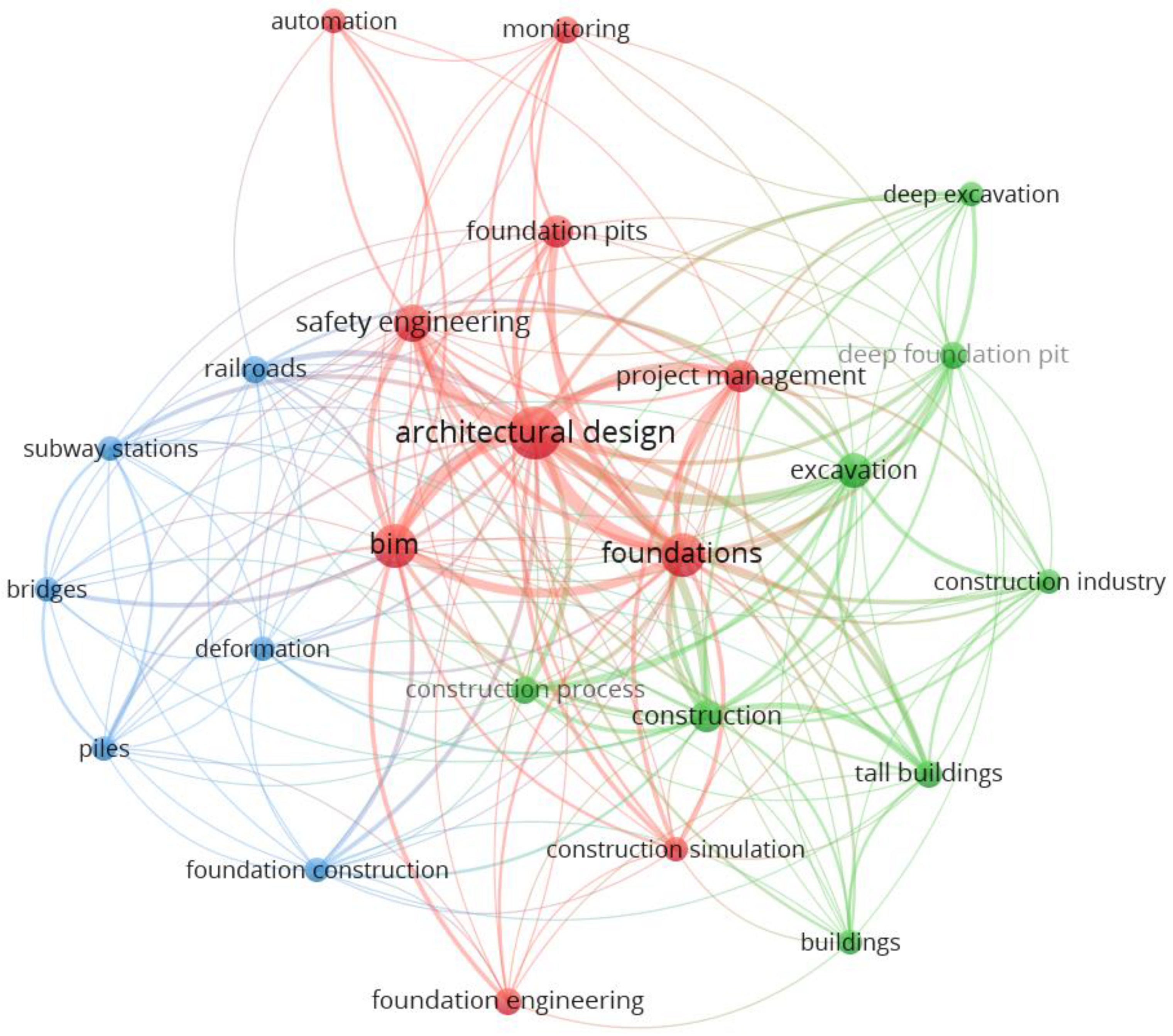




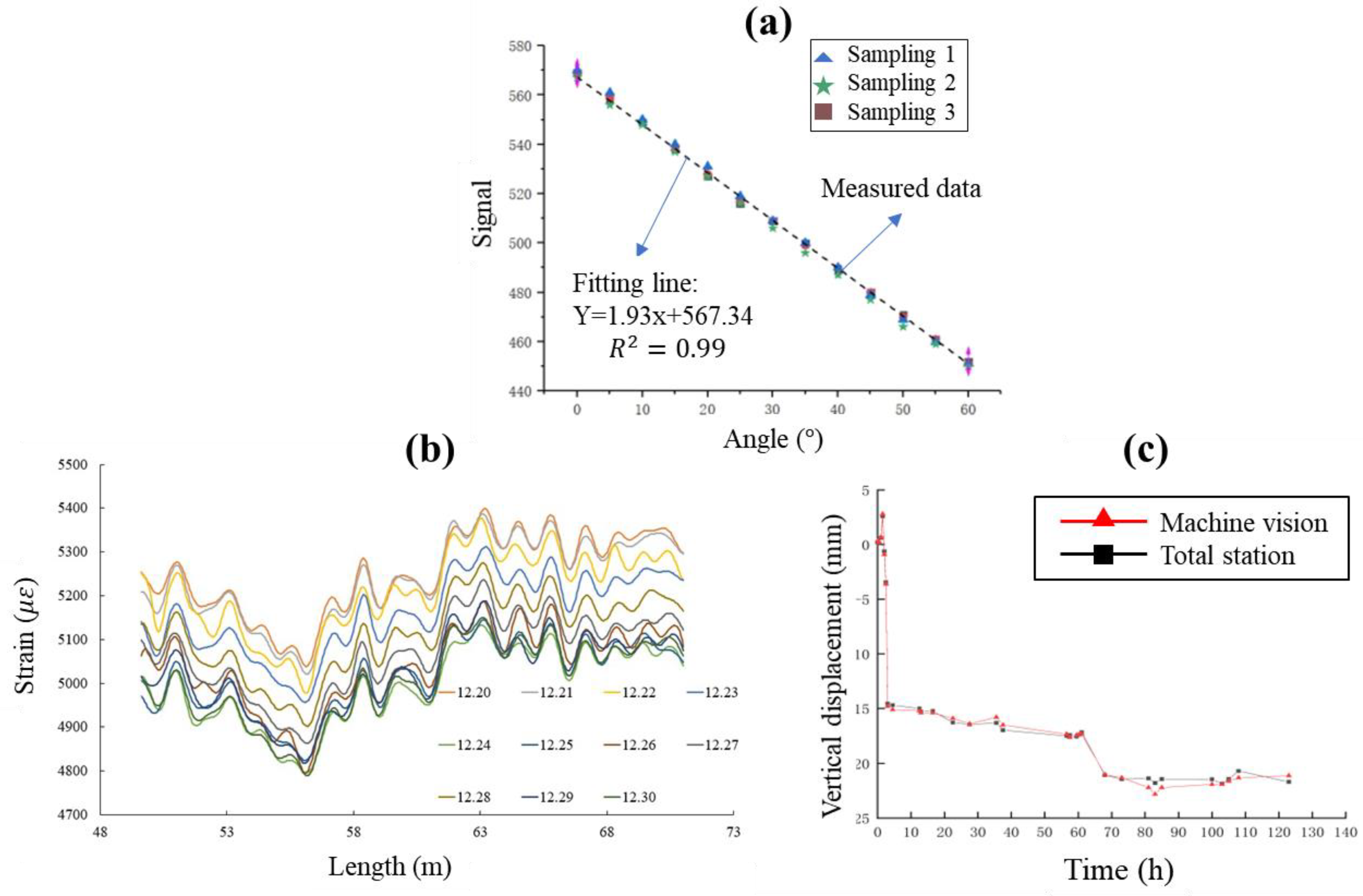
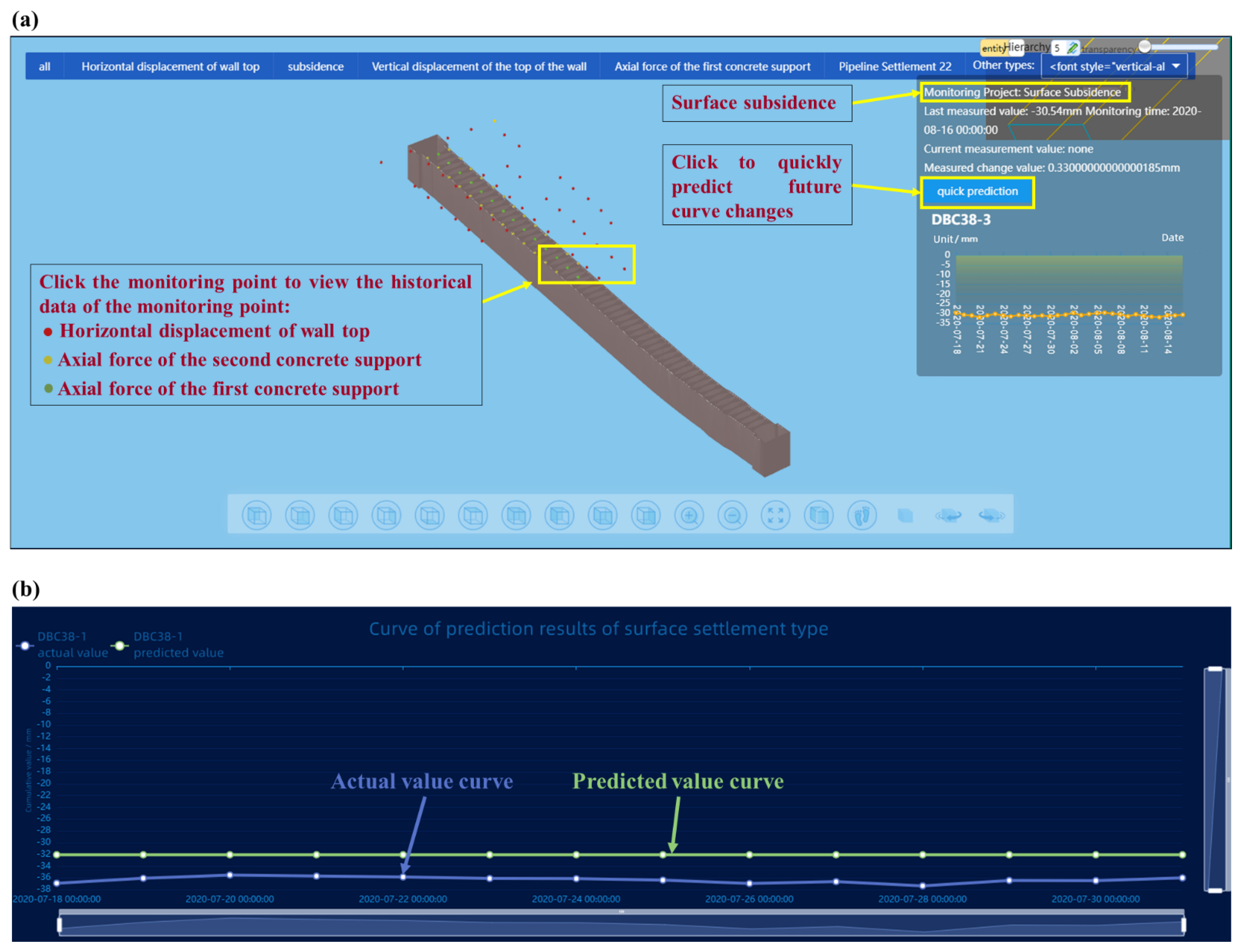
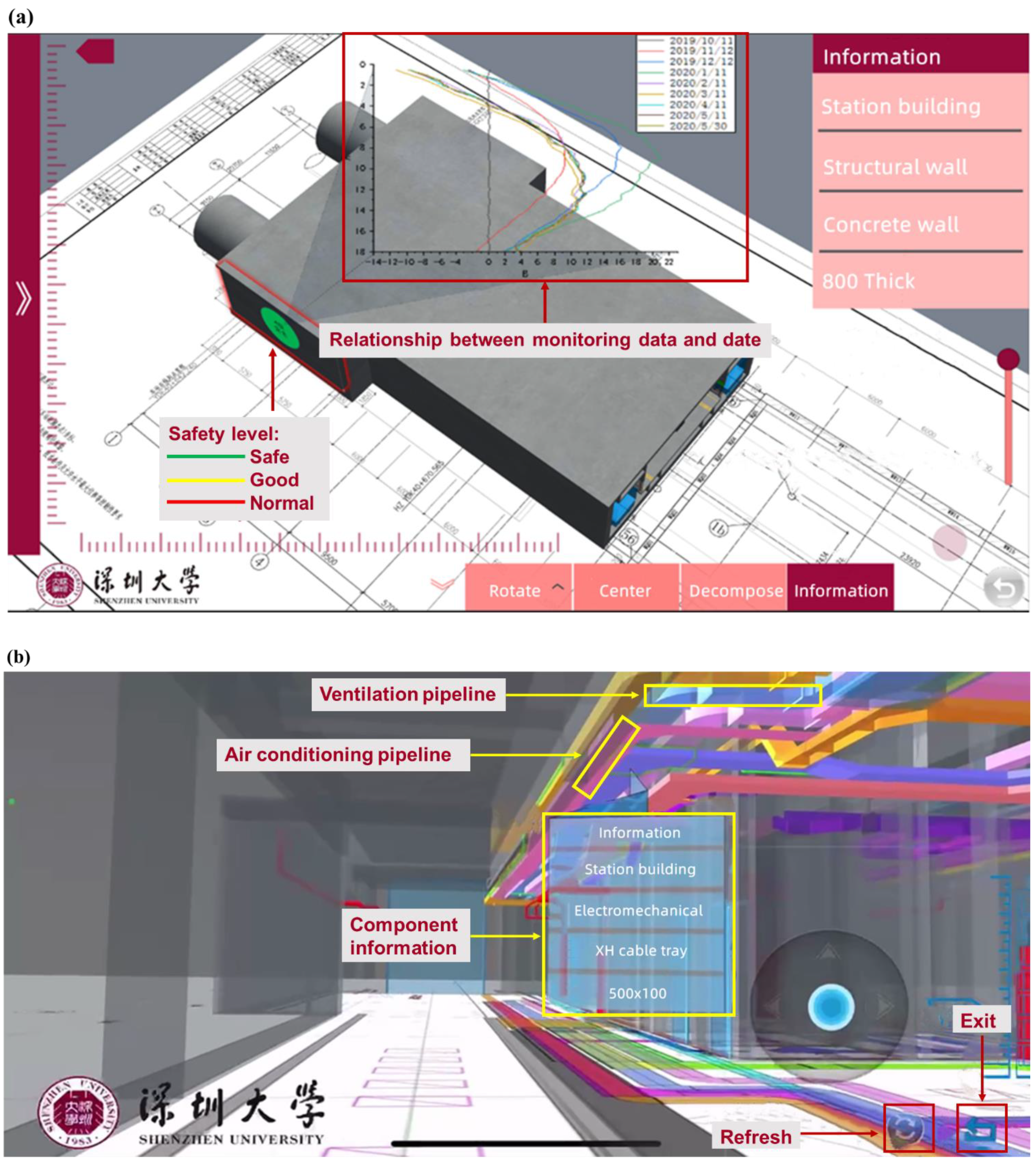
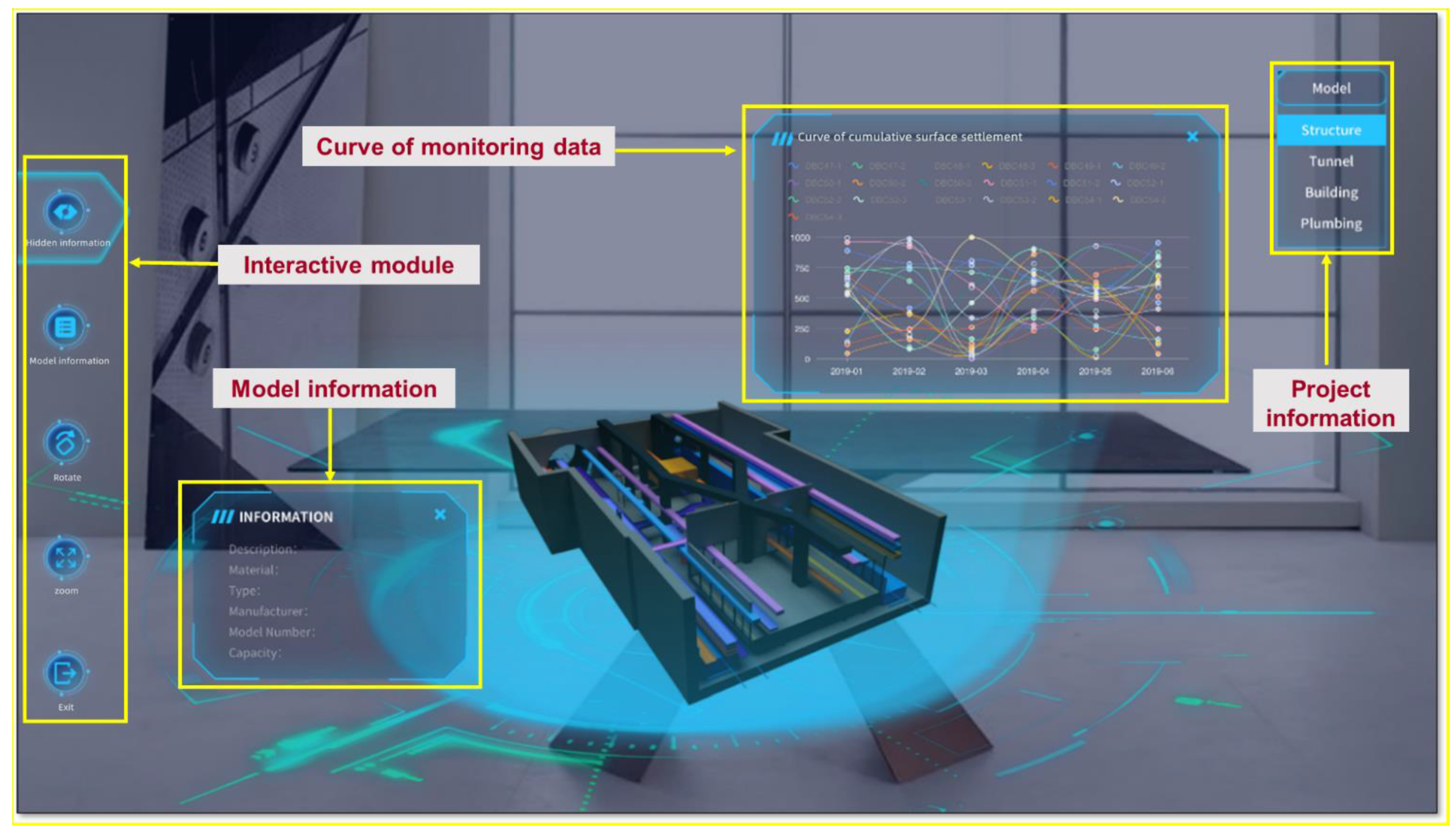

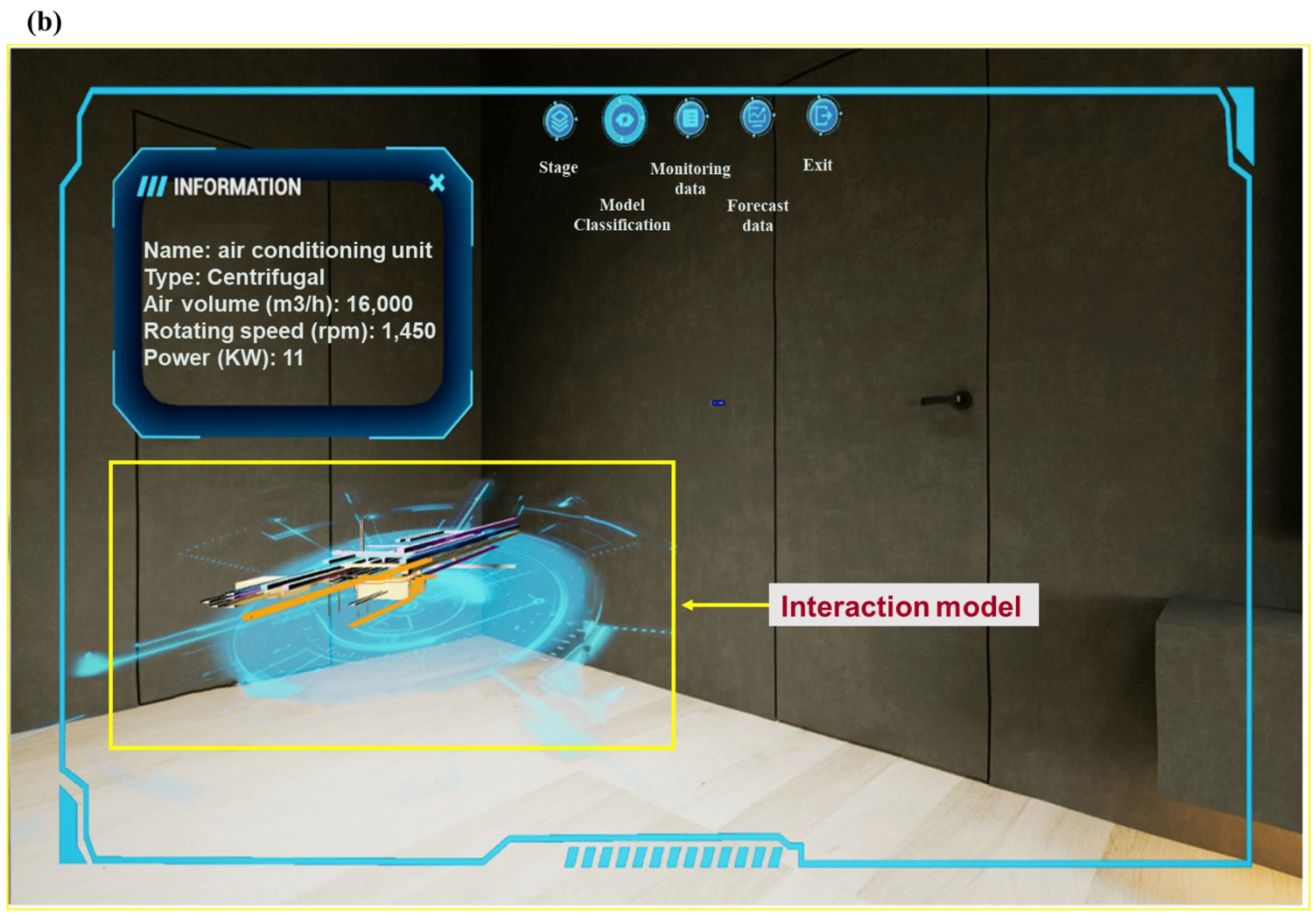

Publisher’s Note: MDPI stays neutral with regard to jurisdictional claims in published maps and institutional affiliations. |
© 2022 by the authors. Licensee MDPI, Basel, Switzerland. This article is an open access article distributed under the terms and conditions of the Creative Commons Attribution (CC BY) license (https://creativecommons.org/licenses/by/4.0/).
Share and Cite
Hong, C.; Zhang, J.; Chen, W. An Integrated Intelligent Approach for Monitoring and Management of a Deep Foundation Pit in a Subway Station. Sensors 2022, 22, 8737. https://doi.org/10.3390/s22228737
Hong C, Zhang J, Chen W. An Integrated Intelligent Approach for Monitoring and Management of a Deep Foundation Pit in a Subway Station. Sensors. 2022; 22(22):8737. https://doi.org/10.3390/s22228737
Chicago/Turabian StyleHong, Chengyu, Jinyang Zhang, and Weibin Chen. 2022. "An Integrated Intelligent Approach for Monitoring and Management of a Deep Foundation Pit in a Subway Station" Sensors 22, no. 22: 8737. https://doi.org/10.3390/s22228737




